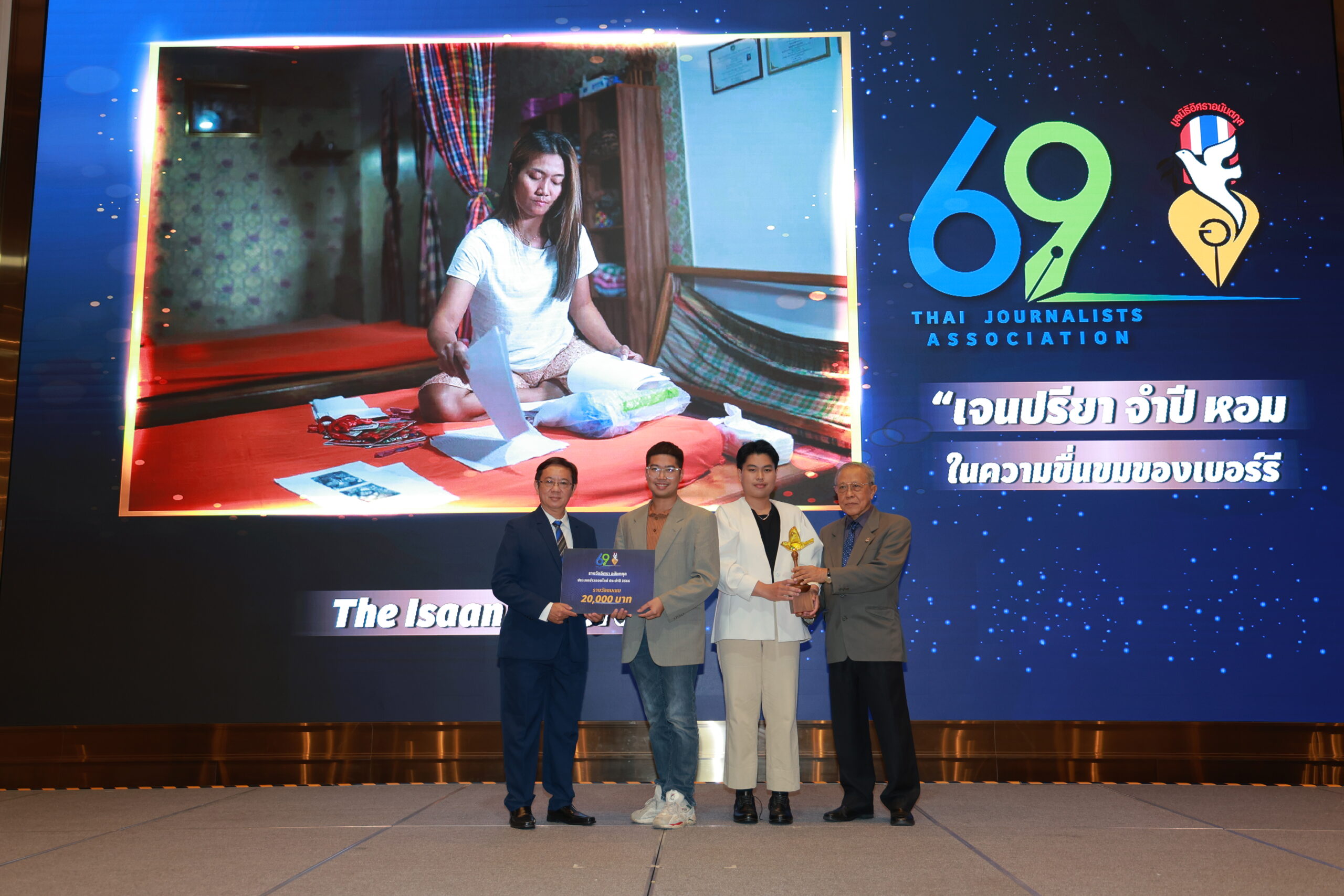SISAKET – Last week a rallying cry went out to the Isaan literati from Sisaket Rajabhat University. It was for an end to the quaintly romantic and patronizing caricature of the region espoused by the Bangkok-centered creative industries, and for Isaan people to take ownership of their own cultural narrative.
In a discussion forum titled “Isaan Literature: The art of self-expression during times of transformation,” writers, academics and teachers-to-be stressed the need to stake a claim for genuine Isaan identity in the literary sphere.
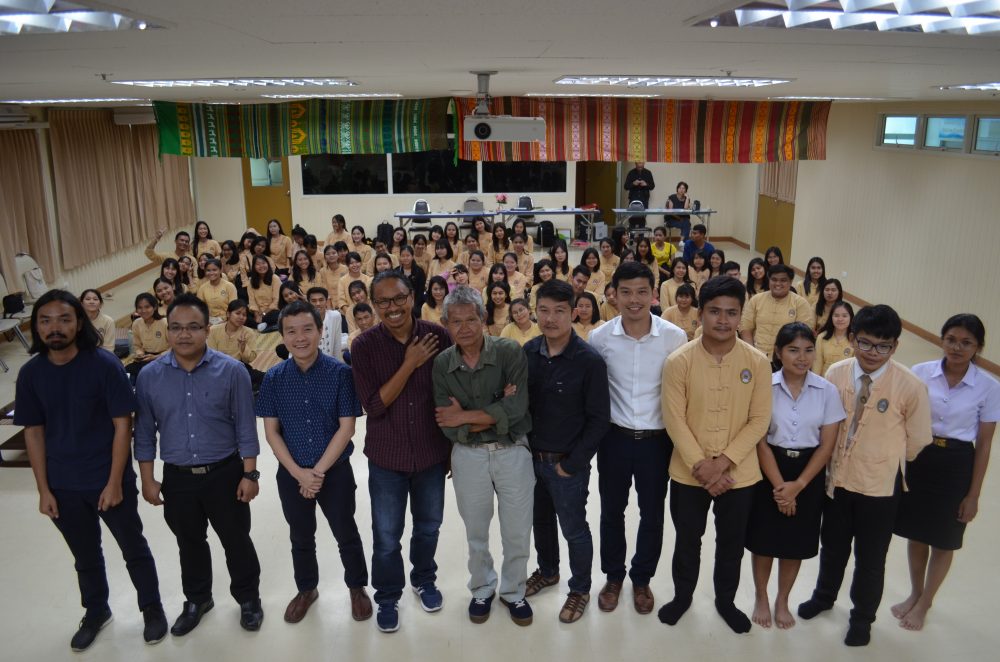
The event was organized by fourth year Thai-major students at the Faculty of Education, Associate Dean Chaanont Chaithongdee, and The Isaan Record with support from the Heinrich Böll Foundation.
Setting the scene
Singer, songwriter and lecturer at the university’s College of Law and Government Prajuab Janmuen–also known by his stage name “Gui E’Goeng”–kicked off proceedings with a set of three songs interspersed by a running soliloquy. By turns he sang and told the stories of lovesick and homesick migrant workers longing for the smell of rice paddies, of being forced out of the village by economic necessity, and of village chiefs directing villagers hither and thither at the whims of central government in Bangkok.
It is necessary to recount these themes, Mr. Prajuab reminded the audience, because the past is the context of the present. In days gone by, the lack of good infrastructure meant that travel outside of one’s village was rare, forcing community members to be mutually reliant upon each other for labor and other forms of support.
When globalization put Thailand on the path of an accelerated industrial revolution several decades ago, these community bonds were broken. Bangkok and the rest of the industrializing world began to suck raw resources, including the human variety, out of Isaan to feed economic growth. This extraction, says Mr. Prajuab, is partly why Isaan is “no longer of old, but not yet modern.”
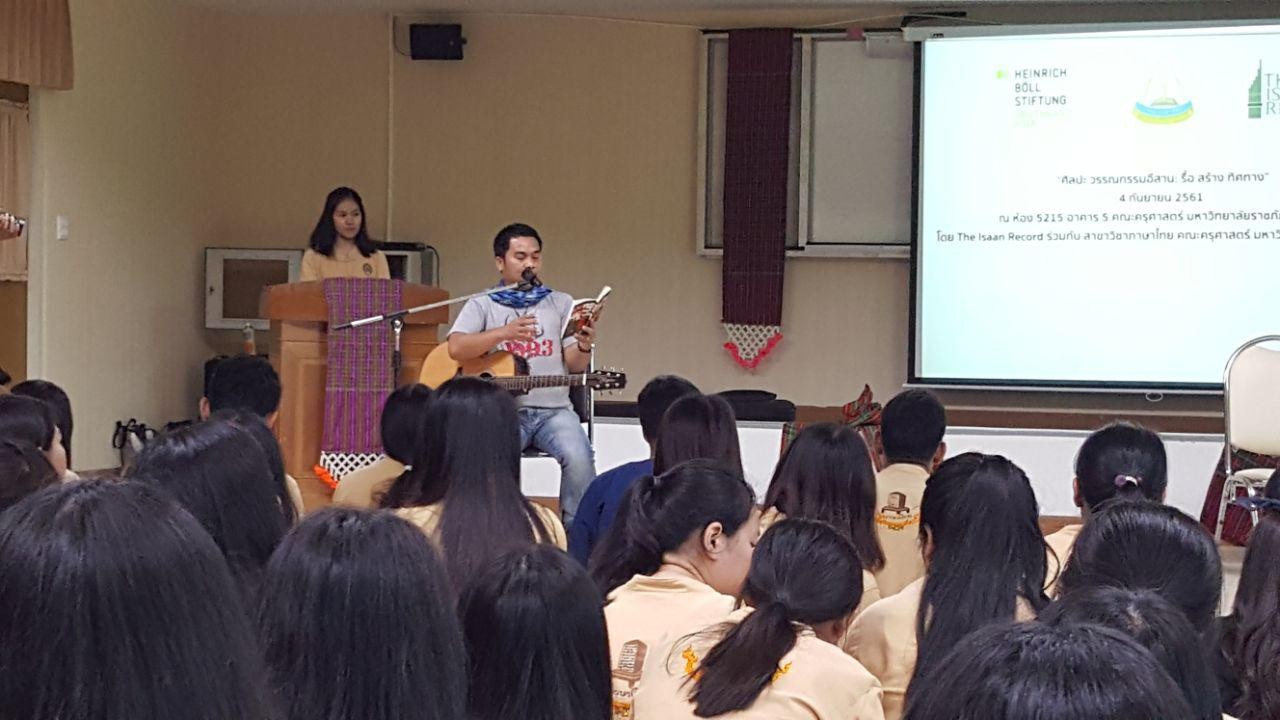
”Focusing on romantic ideals of Isaan as it was distracts us from dealing with Isaan as it is,” said Prajuab Janmuen.
Telling a new story
Mr. Prajuab and his guitar made way for a discussion of the topic “a new generation of Isaan literature.” The students on the discussion panel were variously current Sisaket Rajabhat University students and Sisaket natives studying in Bangkok.
As the facilitator, Mr. Chaanont began by congratulating the student panel on being readers and writers in the first place. “When I ask my teaching students about their favourite reading, most can only offer the epic of Phra Aphai Mani,” he revealed to knowing laughter from the audience. Phra Aphai Mani is compulsory school reading.
He then started the discussion with a quick impression of the way Isaan is currently portrayed. “The film industry still likes to portray us as clowns,” he lamented. “Even the Lao speaking films with all-Isaan casts portray us as clowns with silly haircuts. Why are there never any stories featuring the growing middle-class here, for instance?” He pointed out that as the most populous region of Thailand, Isaan is home to many large cities and universities, and is not completely bereft of modern sophistication and contemporary stories to tell.
Final year student Cheerayut Akkhaboot concurred. “Why are we still wheeling out stories about the poor farmers of Isaan [in popular media] when every region has poor farmers,” he questioned. “Isaan has rich and powerful people too, the educated live here too.”
He who pays the piper calls the tune
Fifth year student and published author Pornpairin Nammanut agreed. “I grew up to the media-spun image of a dry and barren Isaan. It’s ridiculous to think that I actually used to believe it,” she confessed. “Isaan is lush and abundant, as we can all see with our own eyes!”
Ms. Pornpairin told of how the constant social propaganda about “poor Isaan” made her disbelieve much of the verbal history told to her by her elders, “yet when I read into our history for myself I found that their stories were corroborated.”
Who is creating this plastic Isaan identity, and who is consuming it? This question was posed to the panel and the audience by Mr. Chaanont. The consensus was that while Bangkok and the rest of Thailand do consume this fake version of Isaan, they can hardly be expected to know any better without having set foot in Isaan. Mr. Chaanont offered that the biggest culprits in enabling this false narrative are the Isaan people themselves.
“We’ve been self-hypnotized by the narrative of lack and victimhood,” he said.
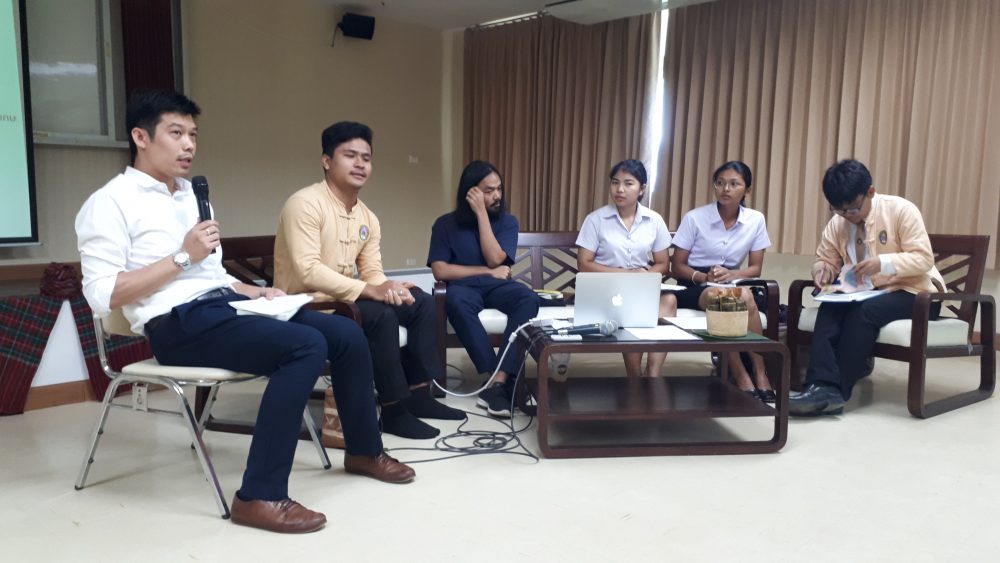
Chaanont Chaithongdee and young Isaan writers Nattaphong Chalermphong, Thanawat Nomcharoern, Kanda Prachoomwong, Pornpairin Nammanut, and Cheerayut Akkhabut.
The ghost of Isaan’s past
Though the word “Isaan” (a derivative of a Sanskrit word for the northeasterly direction) has been in common usage for at least a century, the Isaan identity as we know it today is a more recent construction. Pushed for during the mid 20th century by Field Marshal Plaek Phiboolsongkram, it was designed to decouple the Lao-speaking majority of Isaan’s population from their cultural kin across the Mekong River.
Thanawat Nomcharoern, a Sisaket native and art student at Silpakorn University in Bangkok, added that his professors refused to approve his chosen topic of the 1960’s communist insurgency in Isaan for his artistic projects. “They told me it was a dead topic, not contemporary,” he said. “But to me it’s not dead at all. Isaan still bears the trauma of being in the crossfire between government forces and the communists.”
He wryly observed that for all its supposed progressiveness, Silpakorn–widely regarded as Thailand’s foremost institution for art–still seems to be more interested in images of buffaloes in rice paddies and quaint country folk happily doing the lamwong dance around the village.
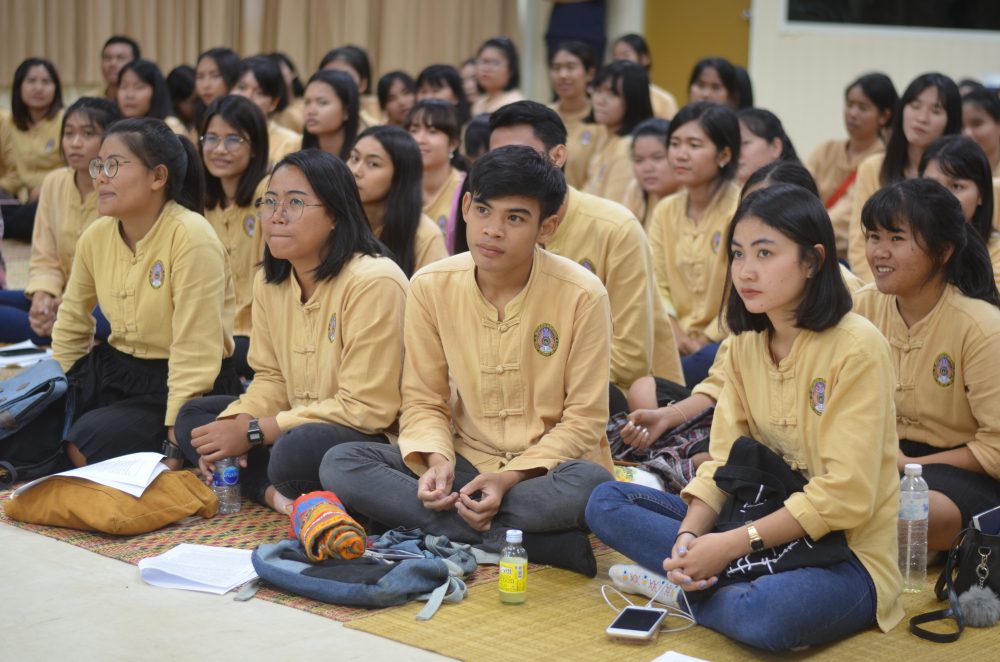
The student organizers opted for traditional woven mat seating, telling the audience to make themselves at home since they are in Isaan.
There is more than one Isaan
Across Thailand the epithet “Isaan” is synonymous with the Lao-speaking, Lao-eating, Lao-singing and dancing aspect of this region, but using the word Isaan in this way is failing to acknowledge the plethora of regional accents, dialects, and ethnicities which live on this plateau. Mr. Cheerayut recounted being laughed at for speaking with a Sisaket accent, which is unique in Isaan. “We should be celebrating this linguistic diversity,” he said. “We are not less human for not speaking like everyone else.”
Fellow panelist, fifth year student Nattapong Chalermphong added that “in other countries such as Britain, different accents are celebrated. They still make fun of each other’s accents there but they are spoken with pride nevertheless. I think we can learn from that,” he reflected. “Perhaps that’s where we’re heading.”
Kanda Prachoomwong, a trainee teacher from a Khmer speaking family in Sisaket gave her perspective. “Khmer culture is also a part of Isaan, yet I am under constant pressure to play down my Khmerness,” she confessed. “Even some of my lecturers tell me that as a Thai-major teaching student I should speak less Khmer in everyday life.”
Ms. Kanda shared that though she used to find it depressing, she now wins this war everyday. “When people look askance at me for speaking Khmer I just swish my bob at them,” she laughed, to cheers from the audience.
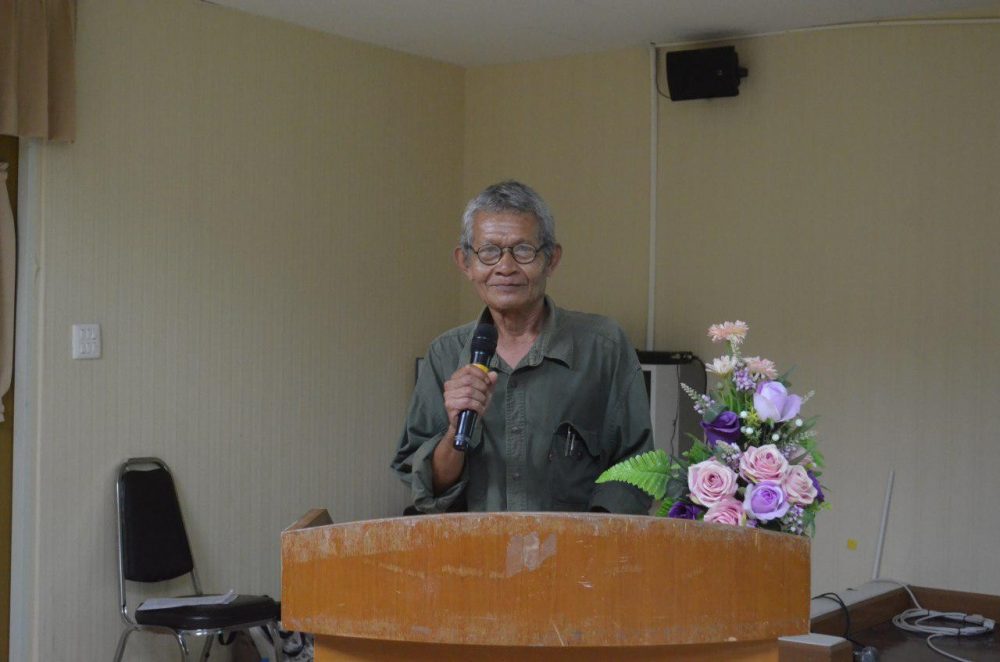
“To be robbed of your literary voice leads to being robbed of your culture, and finally, being robbed of your identity,” Manot Phromsing cautioned the young audience.
Decolonizing the Isaan mind
Manot Phromsing, editor of the Chai Kha Rueang San short-story compilations, gave a spirited speech in which he branded this kind of behaviour as typical of imperialist insecurity.
“Prior to accepting Siamese suzerainty, this region was a thriving confederation of free states and principalities, loosely linked by trade and cultural kinship,” Mr. Manot lectured, drawing comparisons to the Ionian League of ancient Greece.
“Isaan was diverse, Isaan was dynamic, Isaan was culturally and artistically rich. Fascism and dictatorship are anathema to our pre-colonization roots.” Echoing the sentiments of Mr. Chaanont, Mr. Manot emphasized that decolonization must start within the minds of Isaan people themselves.


